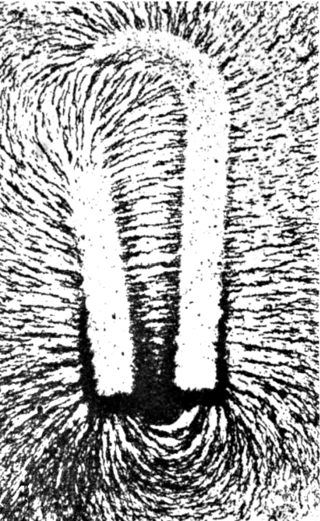| Separate the Magnets | ||||
|---|---|---|---|---|
 | ||||
| Studio album by | ||||
| Released | July 24, 1998 | |||
| Genre | Emocore, hardcore punk | |||
| Label | Second Nature Recordings | |||
| Grade chronology | ||||
| ||||
Separate the Magnets is the second full-length studio album by the hardcore band Grade.
| Separate the Magnets | ||||
|---|---|---|---|---|
 | ||||
| Studio album by | ||||
| Released | July 24, 1998 | |||
| Genre | Emocore, hardcore punk | |||
| Label | Second Nature Recordings | |||
| Grade chronology | ||||
| ||||
Separate the Magnets is the second full-length studio album by the hardcore band Grade.

Ferromagnetism is a property of certain materials that results in a significant, observable magnetic permeability, and in many cases, a significant magnetic coercivity, allowing the material to form a permanent magnet. Ferromagnetic materials are familiar metals that are noticeably attracted to a magnet, a consequence of their substantial magnetic permeability. Magnetic permeability describes the induced magnetization of a material due to the presence of an external magnetic field. This temporarily induced magnetization, for example, inside a steel plate, accounts for its attraction to the permanent magnet. Whether or not that steel plate acquires a permanent magnetization itself depends not only on the strength of the applied field but on the so-called coercivity of the ferromagnetic material, which can vary greatly.

A magnetic field is a vector field that describes the magnetic influence on moving electric charges, electric currents, and magnetic materials. A moving charge in a magnetic field experiences a force perpendicular to its own velocity and to the magnetic field. A permanent magnet's magnetic field pulls on ferromagnetic materials such as iron, and attracts or repels other magnets. In addition, a nonuniform magnetic field exerts minuscule forces on "nonmagnetic" materials by three other magnetic effects: paramagnetism, diamagnetism, and antiferromagnetism, although these forces are usually so small they can only be detected by laboratory equipment. Magnetic fields surround magnetized materials, and are created by electric currents such as those used in electromagnets, and by electric fields varying in time. Since both strength and direction of a magnetic field may vary with location, it is described mathematically by a function assigning a vector to each point of space, called a vector field.

A compass is a device that shows the cardinal directions used for navigation and geographic orientation. It commonly consists of a magnetized needle or other element, such as a compass card or compass rose, which can pivot to align itself with magnetic north. Other methods may be used, including gyroscopes, magnetometers, and GPS receivers.

A magnet is a material or object that produces a magnetic field. This magnetic field is invisible but is responsible for the most notable property of a magnet: a force that pulls on other ferromagnetic materials, such as iron, steel, nickel, cobalt, etc. and attracts or repels other magnets.

An electric motor is an electrical machine that converts electrical energy into mechanical energy. Most electric motors operate through the interaction between the motor's magnetic field and electric current in a wire winding to generate force in the form of torque applied on the motor's shaft. An electric generator is mechanically identical to an electric motor, but operates with a reversed flow of power, converting mechanical energy into electrical energy.

In electricity generation, a generator is a device that converts motion-based power or fuel-based power into electric power for use in an external circuit. Sources of mechanical energy include steam turbines, gas turbines, water turbines, internal combustion engines, wind turbines and even hand cranks. The first electromagnetic generator, the Faraday disk, was invented in 1831 by British scientist Michael Faraday. Generators provide nearly all the power for electrical grids.

An electromagnet is a type of magnet in which the magnetic field is produced by an electric current. Electromagnets usually consist of wire wound into a coil. A current through the wire creates a magnetic field which is concentrated in the hole in the center of the coil. The magnetic field disappears when the current is turned off. The wire turns are often wound around a magnetic core made from a ferromagnetic or ferrimagnetic material such as iron; the magnetic core concentrates the magnetic flux and makes a more powerful magnet.

A magnetic stirrer or magnetic mixer is a laboratory device that employs a rotating magnetic field to cause a stir bar immersed in a liquid to spin very quickly, thus stirring it. The rotating field may be created either by a rotating magnet or a set of stationary electromagnets, placed beneath the vessel with the liquid. It is used in chemistry and biology as a convenient way to stir small volumes and where other forms of stirring, such as overhead stirrers and stirring rods, may not be viable.
In the U.S. education system, magnet schools are public schools with specialized courses or curricula. Normally a student will attend an elementary school, and this also determines the middle school and high school they attend, unless they move. "Magnet" refers to how magnet schools accept students from multiple different schools in the area, pulling students out of the normal progression of schools. Attending them is voluntary.

In electromagnetism, eddy currents are loops of electric current induced within conductors by a changing magnetic field in the conductor according to Faraday's law of induction or by the relative motion of a conductor in a magnetic field. Eddy currents flow in closed loops within conductors, in planes perpendicular to the magnetic field. They can be induced within nearby stationary conductors by a time-varying magnetic field created by an AC electromagnet or transformer, for example, or by relative motion between a magnet and a nearby conductor. The magnitude of the current in a given loop is proportional to the strength of the magnetic field, the area of the loop, and the rate of change of flux, and inversely proportional to the resistivity of the material. When graphed, these circular currents within a piece of metal look vaguely like eddies or whirlpools in a liquid.

A magnetic cartridge, more commonly called a phonograph cartridge or phono cartridge or (colloquially) a pickup, is an electromechanical transducer that is used to play records on a turntable.

Mount Magnet is a town in the Mid West region of Western Australia. It is one of the region's original gold mining towns, and the longest surviving gold mining settlement in the state. The prominent hill that is adjacent to the current townsite was called West Mount Magnet in 1854 by explorer Robert Austin, having named a smaller hill 64 km away, East Mount Magnet. Both hills had an extremely high iron content which affected the readings of his compass. West Mount Magnet had its Aboriginal name reinstated by the Surveyor General in 1972, "Warramboo," meaning campfire camping place. The magnetic variation at Mount Magnet is zero: magnetic north equals true north.
Charleston County School District is a school district within Charleston County, South Carolina, United States. It educates roughly 50,000 kindergarten to 12th grade students in 80 schools. Charleston County School District’s (CCSD) Board of Trustees voted Monday, June 27, 2022, to name Donald R. Kennedy, Sr., the Superintendent of Schools. Kennedy has served as CCSD’s Interim Superintendent since January 2022.

A magnetic track brake is a brake for rail vehicles. It consists of brake magnets, pole shoes, a suspension, a power transmission and, in the case of mainline railroads, a track rod. When current flows through the magnet coil, the magnet is attracted to the rail, which presses the pole shoes against the rail, thereby decelerating the vehicle.

John B. Alexander High School is a secondary school in Laredo, Texas, United States and a part of the United Independent School District.
Silva Magnet High School is a health-focused magnet high school within the El Paso Independent School District in El Paso, Texas.

The East Baton Rouge Parish School System, also known as East Baton Rouge Schools or the East Baton Rouge Parish School Board, is a public school district headquartered in Baton Rouge, Louisiana, United States. The district serves most of East Baton Rouge Parish; it contains 54 elementary schools, 16 middle schools, and 18 high schools.

A dynamo is an electrical generator that creates direct current using a commutator. Dynamos were the first electrical generators capable of delivering power for industry, and the foundation upon which many other later electric-power conversion devices were based, including the electric motor, the alternating-current alternator, and the rotary converter.
Magnet is a British kitchen retailer operating in over two hundred locations across the United Kingdom supplying products under the Magnet and Magnet Trade brands. The company has over 2,000 employees and its headquarters are in Darlington, County Durham.
Magnetic separation is the process of separating components of mixtures by using a magnet to attract magnetic substances. The process that is used for magnetic separation separates non-magnetic substances from those which are magnetic. This technique is useful for the select few minerals which are ferromagnetic and paramagnetic. Most metals, including gold, silver and aluminum, are nonmagnetic.